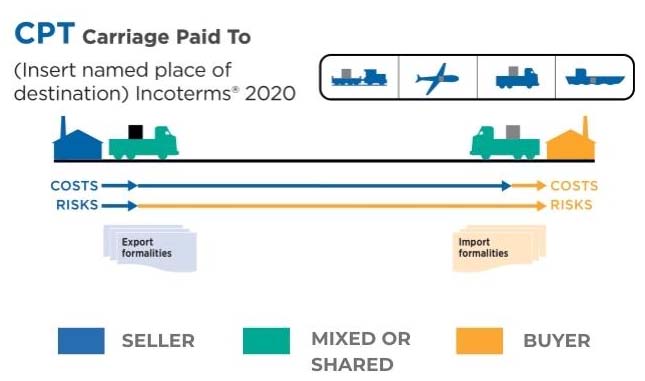CPT Bezahlte Beförderung nach: Die bezahlte Passage
Beim Begriff CPT Carriage Paid To zahlt der Verkäufer die Beförderung bis zum benannten Bestimmungsort, aber das Risiko geht auf den Käufer über, sobald die Ware dem ersten Beförderer übergeben wurde. Stellen Sie sich vor, Sie sitzen bequem im Zug und wissen, dass Ihre Fahrkarte bereits bezahlt ist. Das ist CPT. Das 1980 eingeführte CPT ist eine moderne Variante des CFR und spiegelt die Verlagerung vom Seeverkehr zum multimodalen Transport wider.
Die Verpflichtungen des Verkäufers:
Übergeben Sie die Waren dem Frachtführer am benannten Versandort.
Bezahlen Sie die Kosten für die Beförderung zum angegebenen Bestimmungsort.
Abfertigung der Waren zur Ausfuhr.
Die Verpflichtungen des Käufers:
Verzollung der Waren zur Einfuhr, Zahlung etwaiger Zölle.
Sie tragen alle Risiken des Verlusts oder der Beschädigung, sobald die Waren an den Spediteur übergeben wurden.

CPT-Instanz:
CPT: Beförderung bezahlt an
Anhand eines Beispiels wollen wir die Preisgestaltung und den Versand unter dem Incoterm CPT (Carriage Paid To) erläutern.
Wir können folgendes Szenario verwenden: Ein chinesischer Verkäufer versendet elektronische Produkte an einen Käufer in den Vereinigten Staaten.
Die Kosten würden sich folgendermaßen zusammensetzen:

- Produktkosten: Der vereinbarte Preis für die Elektronik beträgt $20.000.
- Lokale Logistik: Kosten für die Lieferung der Waren vom Lager zum Hafen in China (Verantwortung des Verkäufers), sagen wir $1.000.
- Exportzollabfertigung: Kosten für die Abfertigung der Waren zur Ausfuhr durch den chinesischen Zoll (Verantwortung des Verkäufers), sagen wir $500.
- Frachtkosten: Kosten für den Transport der Waren über den Ozean zum Bestimmungshafen in den USA (gemäß CPT in der Verantwortung des Verkäufers), sagen wir $2.000.
Die Gesamtkosten für den Verkäufer (CPT-Preis) betragen also $20.000 + $1.000 + $500 + $2.000 = $23.500.
Versand:
- Einfuhrzollabfertigung: Zölle und Steuern für Waren, die vom US-Zoll abgefertigt werden müssen (Verantwortung des Käufers), sagen wir $3.000.
- Lokale Logistik: Kosten für die Lieferung der Waren vom Hafen zum Lager des Käufers in den USA (auf Verantwortung des Käufers), sagen wir $1.000.
Die Gesamtkosten für den Käufer sollten sich also aus dem CPT-Preis ($23.500) plus den Kosten für die Einfuhrzollabfertigung ($3.000) und die lokale Logistik ($1.000) zusammensetzen. Das heißt, $23,500 + $3,000 + $1,000 = $27,500.
Bei den CPT ist der Verkäufer verpflichtet, die Beförderung der Ware zum vereinbarten Bestimmungsort zu veranlassen und zu bezahlen, aber das Risiko geht vom Verkäufer auf den Käufer über, sobald die Ware dem ersten Frachtführer übergeben worden ist, was sich von der FOB-Klausel unterscheidet.
Welcher Begriff ist mit CPT abgeschlossen?
Der Incoterm, der dem CPT am ähnlichsten ist, lautet CIP (Beförderung und Versicherung bezahlt). In beiden Fällen ist der Verkäufer verpflichtet, den Transport der Waren zu einem bestimmten Bestimmungsort zu organisieren und zu bezahlen. Der Hauptunterschied besteht darin, dass der Verkäufer bei der CIP auch eine Versicherung gegen das Risiko des Käufers für den Verlust oder die Beschädigung der Ware während der Beförderung abschließen und bezahlen muss. Unter beiden Bedingungen muss der Verkäufer den Transport organisieren und bezahlen, aber nur unter CIP muss er auch eine Versicherung abschließen. Das Risiko des Verlusts oder der Beschädigung geht in beiden Fällen vom Verkäufer auf den Käufer über, sobald die Ware dem ersten Frachtführer übergeben wurde.


